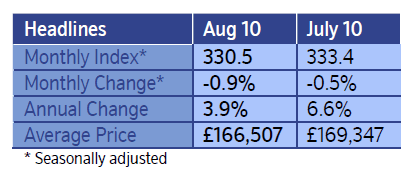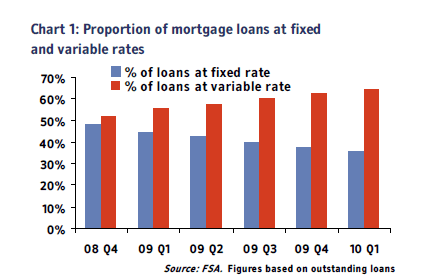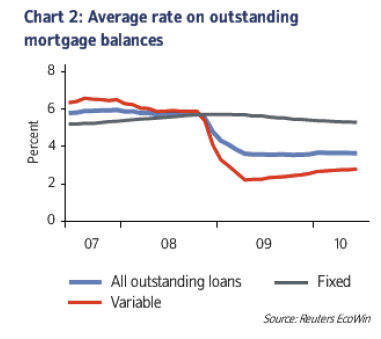UK House Prices Fall For Second Consecutive Month
Housing-Market / UK Housing Sep 02, 2010 - 09:52 AM GMTBy: Nationwide
 House prices fell by 0.9% in August
House prices fell by 0.9% in August
- Three month rate of change shows price stagnation over the summer
- Percentage of borrowers on variable rates has increased

Commenting on the figures Martin Gahbauer,
Nationwide's Chief Economist, said:
“House prices fell by 0.9% month-on-month (m/m) in August, following a decline of 0.5% m/m in July. This is the first time since February 2009 that house prices have fallen in two consecutive months. The 3 month on 3 month rate of change – generally a smoother indicator of the recent price trend – fell from 1.2% in July to 0.0% in August, suggesting that house prices have essentially stagnated over the summer. Unless house prices bounce back strongly in September, the three month rate of change will turn negative next month. The annual rate of inflation – which compares the current average price with the price level twelve months ago – remained in positive territory at 3.9%. However, it is down quite sharply from rates of 6.6% in July and 8.7% in June.
“Recent market trends remain consistent with an unwinding of the supply-demand imbalance that drove up prices for much of the last year. As more sellers have returned to the market, buyers have a greater selection of properties to choose from and more bargaining power with which to bid down asking prices. There is little evidence of distressed selling, however, with the Council of Mortgage Lenders’ second quarter figures showing another drop in mortgage arrears and possessions. As such, the current period of price declines is likely to remain relatively modest. Given that the price increases of the last year had gotten ahead of the recovery in the wider economy, the current correction is not an unhealthy development.
More borrowers on variable rates
“Over the last two years, there have been significant changes to the characteristics of the mortgage stock, particularly with regard to the proportion of lending on fixed rate mortgages. Between the final quarter of 2008 and the first quarter of 2010, the proportion of mortgage balances on fixed rates fell from 48% to 36%, as fewer borrowers coming to the end of a fixed rate deal chose to remortgage onto a new fixed rate. This is primarily because of the availability of attractive standard variable rates.

“Borrowers on variable rates have experienced a very large cash flow benefit from the reduction in the Bank of England base rate in late 2008 and early 2009. The average rate paid on variable rate mortgage balances across the market was only 2.8% in June, compared to 5.9% in September 2008 and 5.3% for fixed rate balances (Source: Bank of England). The additional cash flow from lower mortgage rates has been instrumental in keeping arrears and possessions relatively low during the recession, helping house prices to stage the rebound seen between early 2009 and the middle of 2010.

“However, while the increasing proportion of variable rate mortgage balances has allowed more borrowers to benefit from the low level of the Bank of England base rate, it also means that more households are exposed to potential future increases in interest rates. Should the proportion of variable rate mortgage balances remain high, the impact of base rate increases on monthly repayments, and therefore house prices, may be larger than in the past.
“At the moment, however, interest rates appear likely to remain at their current level until well into 2011. Any increases thereafter are likely to be relatively gradual, leaving variable rate borrowers with some time to switch to fixed rates if they desire greater certainty over their monthly repayments.”
| Martin Gahbauer
Chief Economist Tel: 01793 655434 fionnuala.earley@nationwide.co.uk |
Roy Beale Media Relations Officer Tel: 01793 655689 roy.beale@nationwide.co.uk |
Notes: Indices and average prices are produced using Nationwide's updated mix adjusted House Price Methodology which was introduced with effect from the first quarter of 1995. Price indices are seasonally adjusted using the US Bureau of the Census X12 method. Currently the calculations are based on a monthly data series starting from January 1991. Figures are recalculated each month which may result in revisions to historical data. The Nationwide Monthly House Price Index is prepared from information which we believe is collated with care, but no representation is made as to its accuracy or completeness. We reserve the right to vary our methodology and to edit or discontinue the whole or any part of the Index at any time, for regulatory or other reasons. Persons seeking to place reliance on the Index for their own or third party commercial purposes do so entirely at their own risk. All changes are nominal and do not allow for inflation. More information on the house price index methodology along with time series data and archives of housing research can be found at www.nationwide.co.uk/hpi
Nationwide Archive |
© 2005-2022 http://www.MarketOracle.co.uk - The Market Oracle is a FREE Daily Financial Markets Analysis & Forecasting online publication.



